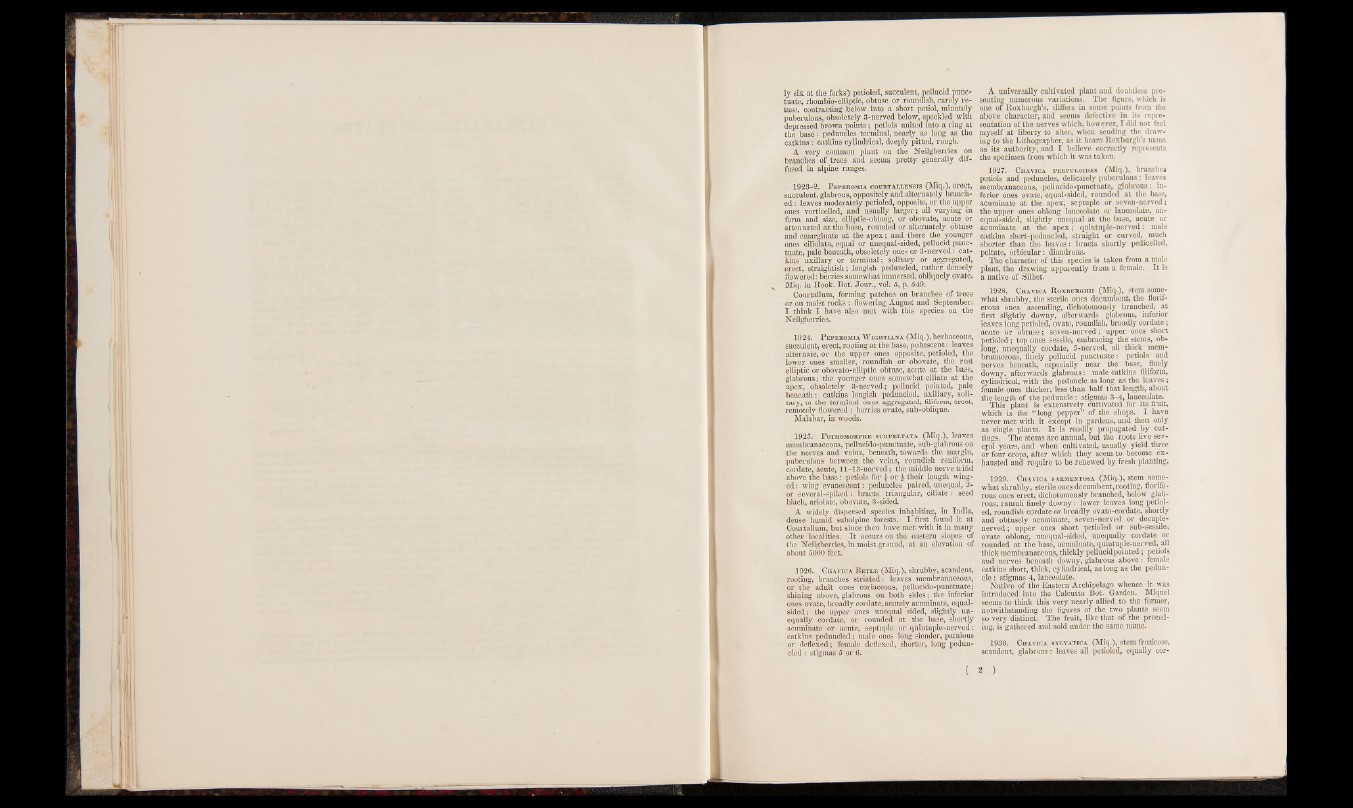
ly six at the forks) petioled, succulent, pellucid punctuate,
rhombic-elliptic, obtuse or roundish, rarely refuse,
contracting below into a short petiol, minutely
puberulous, obsoletely 3-nerved below, speckled^ with
depressed brown points; petiols united into a ring at
the base: peduncles terminal, nearly as long as the
catkins: catkins cylindrical, deeply pitted, rough.
A very common plant on the Neilgherries on
branches of trees and seems pretty generally diffused
in alpine ranges.
1923-2. P eperomia court allensis (Miq.), erect,
succulent, glabrous, oppositely and alternately branched
: leaves moderately petioled, opposite, or the upper
ones verticelled, and usually larger; all varying in
form and size, elliptic-oblong, or obovate, acute or
attenuated at the base, rounded or alternately obtuse
and emarginate at the apex; and there the younger
ones ciliolate, equal or unequal-sided, pellucid punctuate,
pale beneath, obsoletely one- or 3-nerved: catkins
axillary or terminal; solitary or aggregated,
erect, straightish; longish peduncled, rather densely
flowered: berries somewhat immersed, obliquely ovate.
Miq. in Hook. Bot. Jour., vol. 5, p. 549. .
Courtallum, forming patches on branches of trees
or on moist rocks: flowering August and September.
I think I have also met with this species on the
Neilgherries.
1924. P eperomia W ightiana (Miq.), herbaceous,
succulent, erect, rooting at the base, pubescent: leaves
alternate, or the upper ones opposite, petioled, the
lower ones smaller, roundish or obovate, the rest
elliptic or obovato-elliptic obtuse, acute at the base,
glabrous; the younger ones somewhat ciliate at the
apex, obsoletely 3-nerved; pellucid pointed, pale
beneath: catkins longish peduncled, axillary, solitary,
or the terminal ones aggregated, filiform, erect,
remotely flowered: berries ovate, sub-oblique.
Malabar, in woods.
1925. P othomorphe subpeltata (Miq.), leaves
membranaceous, pellucido-punctuate, sub-glabrous on
the nerves and veins, beneath, towards the margin,
puberulous between the veins, roundish reniform,
cordate, acute, 1 1 - 1 3-nerved; the middle nerve trifid
above the base: petiols for i or ^ their length winged
: wing evanescent: peduncles paired, unequal, 2-
or several-spiked: bracts triangular, ciliate: seed
black, ariolate, obovate, 3-sided.
A widely dispersed species inhabiting, in India,
dense humid subalpine forests. I first found it at
Courtallum, but since then have met with it in many
other localities. I t occurs on the eastern slopes of
the Neilgherries, in moist ground, at an elevation of
about 5000 feet.
1926. Chavica B etle (Miq.), shrubby, scandent,
rooting, branches striated: leaves membranaceous,
or the adult ones coriaceous, pellucido-punctuate;
shining above, glabrous on both sides; the inferior
ones ovate, broadly cordate, acutely acuminate, equalsided;
the upper ones unequal sided, slightly unequally
cordate, or rounded at the base, Shortly
acuminate or acute, septuple or quintuple-nerved:
catkins peduncled; male ones long slender, patulous
or deflexed; female deflexed, shorter, long peduncled
: stigmas 5 or 6.
A universally cultivated plant and doubtless presenting
numerous variations. The figure, which is
one of Roxburgh’s, differs in some points from the
above character, and seems defective in its representation
of the nerves which, however, I did not feel
myself at liberty to alter, when sending the drawing
to the Lithographer, as it bears Roxburgh’s name
as its authority, and I believe correctly represents
the specimen from which it was taken.
1927. Chavica peepuloides (Miq.), branches
petiols and peduncles, delicately puberulous: leaves
membranaceous, pellucido-punctuate, g lab ro u s: inferior
ones ovate, equal-sided, rounded at the base,
acuminate a t the apex, septuple or seven-nerved;
the upper ones oblong lanceolate or lanceolate, unequal
sided, slightly unequal at the base, acute or
acuminate at the ap ex ; quintuple-nerved: male
catkins short-peduncled, straight or curved, much
shorter than the leaves: bracts shortly pedicelled,
peltate, orbicular: diandrous.
The character of this species is taken from a male
plant, the drawing apparently from a female. I t is
a native of Silhet.
1928. Chavica R oxburghii (Miq.), stem somewhat
shrubby, the sterile ones decumbent, the florif-
erous ones ascending, dichotomously branched, at
first slightly downy, afterwards glabrous, inferior
leaves long petioled, ovate, roundish, broadly cordate;
acute or obtuse; seven-nerved; upper ones short
petioled; top ones sessile, embracing the stems, oblong,
unequally cordate, 5-nerved, all thick membranaceous,
finely pellucid punctuate: petiols and
nerves beneath, especially near the base, finely
downy, afterwards glabrous: male catkins filiform,
cylindrical, with the peduncle as long as the leaves;
female ones thicker, less than half that length, about
the length of the peduncle: stigmas 3-4, lanceolate.
This plant is extensively cultivated for its fruit,
which is the “ long pepper” of the shops. I have
never met with it except in gardens, and then only
as single plants. I t is readily propagated by cuttings.
The stems are annual, but the roots live several
years, and when cultivated, usually yield three
or four crops, after which they seem to become exhausted
and require to be renewed by fresh planting.
1929. Chavica sarmentosa (Miq.), stem somewhat
shrubby, sterile ones decumbent, rooting, florife-
rous ones erect, dichotomously branched, below glabrous,
ramuli finely downy: lower leaves long petioled,
roundish cordate or broadly ovato-cordate, shortly
and obtusely acuminate, seven-nerved or decuple-
nerved ; upper ones short petioled or sub-sessile,
ovate oblong, unequal-sided, unequally cordate or
rounded at the base, acuminate, quintuple-nerved, all
thick membranaceous, thickly pellucid pointed; petiols
and nerves beneath downy, glabrous above: female
catkins short, thick, cylindrical, as long as the peduncle
: stigmas 4, lanceolate.
Native of the Eastern Archipelago whence it _ was
introduced into the Calcutta Bot. Garden. Miquel
seems to think this very nearly allied to the former,
notwithstanding the figures of the two plants seem
so very distinct. The fruit, like that of the preceding,
is gathered and sold under the same name.
1930. Chavica sylvatica (Miq.), stem fruticose,
scandent, glabrous: leaves all petioled, equally cor